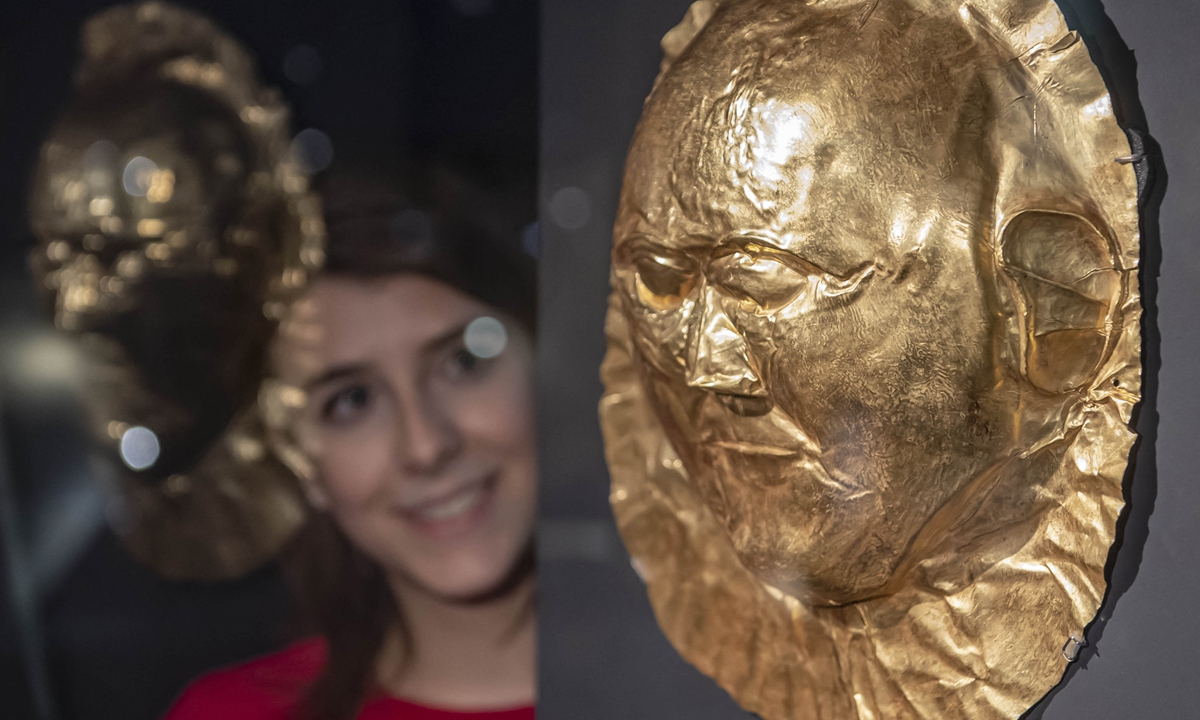ARTS / ART
Ancient Greek golden death masks of Mycenae still an unknown, says archaeologist
Delving into mystery

A woman at the Badisches Landes museum in Karlsruhe Castle looks at a golden tomb mask, part of the exhibition Mycenae - The Legendary World of Agamemnon, in Germany in 2018. Photo: AFP
The imposing golden mask of Agamemnon welcomes visitors at the National Archaeological Museum in Athens, standing out among other finds from the royal cemetery of the ancient city of Mycenae on the Peloponnese peninsula dating back to the 16th century BC.The five in total golden funeral masks and the full face and body coverings of an infant displayed at the museum are still engulfed in mystery, and are a unique case in ancient Greece, Constantinos Paschalidis, curator of Antiquities at the museum, told Xinhua in a recent interview.
Mistaken identity
When German archaeologist Heinrich Schliemann discovered the elegant mask with the intense facial characteristics in 1876, he was certain he had found the tomb of the Mycenaean king Agamemnon mentioned in Homer's epic poem Iliad.
The mask was later dated four centuries before the legendary Trojan War, but is still world-famous as Agamemnon's mask.
"Nowadays we say that it is a conventional name. Agamemnon is a literature person, like Romeo and Juliet. He never existed as a historical person, but we love such connotations, therefore we keep the name due to the romantic aspect of archaeology," Paschalidis said.
Most of the Mycenaen masks at the museum are rather simple and do not depict individual features with the exception of Agamemnon's, which is more or less the portrait of a man who died at the age of around 30, he noted.
The man was bearded, with a mustache and a long "Greek" nose, and whoever he was, he was buried as a king, with all honors, covered with gold, the expert said.
The Mycenaen death masks are very precious and rare objects which were created for very important people, both men and women, he said. Three of them depict men and two women. A few meters further are the golden sheets covering the face and body of a baby, a girl most likely, a few months old.
The sheets of pure gold, roughly 24 carats in today's terms, were hammered from the backside. The repousse technique was used to form the shape, according to Paschalidis.
"There is a huge question regarding the wealth and the gold of Mycenae. Actually, we don't know where it came from and how it started," he told Xinhua.
"We know that these people used to be poor farmers and cattle breeders for centuries, living in the Argolide [region] or the Peloponnese [peninsula] in general and within one generation or one generation and a half around the year 1,600 BC they became extremely wealthy, extremely rich and they started burying their dead covered with gold and exotic materials coming from all over the known or unknown world of that time," he added.
An open question
Together with the precious objects that came from the island of Crete, other regions of the Balkan peninsula and from Egypt, it seems that also new, fresh and extravagant ideas like covering the faces of dead with gold, reached Mycenae by 1600 BC.
"We don't know where exactly the idea came from and who brought it, but it looks like they never had such a tradition before, it only happened in this royal cemetery with these people and it ended with these people. We don't have a tradition going on in the later centuries. Therefore, we consider this phenomenon a unique phenomenon which has to do with Mycenae and these five dead plus the baby, the royal girl," Paschalidis said.
"If one dares to propose something we may say that covering the faces of the dead was a trait which happened in Egypt at that time in the Second Transitional period to the New Kingdom, but then again this doesn't look Egyptian at all. Therefore, keeping the answer strict and archaeological, let's say, correct, we may say it's an open question and a mystery," the curator said.
The masks of Mycenae were offerings to the deceased and not gifts to the gods, he noted.
Paschalidis warmly welcomed the latest great archaeological discovery at the Sanxingdui Ruins site in China's Sichuan Province, where in 2021's spring archaeologists unearthed hundreds of objects, including gold masks, dating to about 1200 BC.
"The recent finds in Sanxingdui ancient city in Sichuan Province is great news for the whole archaeological world and we all feel very happy and excited about it," he said.
"This is more or less a huge archaeological discovery and it is a huge joy and a cause for celebration for archaeologists all over the world," Paschalidis said.



